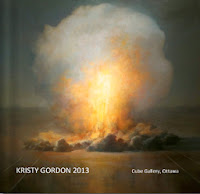STAGE
1
Block in with
Burnt Umber
My canvas is prepared with a
mid-tone greenish grey ground, using white acrylic gesso tinted with a bit of
acrylic Yellow Ochre and a little Mars Black. I let it dry thoroughly then sand
it before beginning the underpainting. Using oily, viscous paint, thinned with
linseed oil, I mark in the basic proportions first. Measuring the proportions
to get the drawing accurate, I compare the width of the head to its
height. Then I mark in three equal
proportions from the chin to the bottom of the nose; bottom of the nose to
eyebrows; and eyebrows to forehead.
Because her head is tilted down, the top distance (from the top of the
head to the hairline) is about an equal proportion to the thirds of the face. Next
I block in the big forms and shadows in Burnt Umber. By “drawing with the
shadows” I am able to establish the placement of the features quickly and
accurately by judging the shapes and distances of the shadow patterns on her
face.
STAGE 2
Color Lay-In and Big Form
Modeling
I begin laying in the color by establishing a basic color for the light
side of the face. I am leaving the
“real” shadows (the cast shadow on the neck and the cast shadows under the
eyebrows and nose), alone for now so that they don’t get mixed up with the
lights. I will go into them later. I
tint the base color in the light side of the face as necessary, such as in the
plane change where the forehead bends up towards the light. Also, the light side of the face gets slightly
darker and cooler as it moves down the face (away from the light) so I make
sure my colors and tones reflect that change. At the edges of the face it also gets darker
and cooler. This helps to establish the
“big form modeling” of the head, rendering the head like an egg by darkening
around the edges, and turning the form to give it dimension.
Describing the Smaller
Forms
I complete the color lay-in
by blocking in a basic color for each element of the painting. For the shadow side of the face I tint the
base flesh color with a mixture of Viridian Green and Cadmium Red Light to
create rich shadow colors. I continue to establish the big form modeling,
making sure that the hair reflects the egg shape of the head, and the head and
body have a cylindrical nature. I paint the hair with a “Grainer” brush, which
has some long hairs and some shorter ones. I lay in distinct brushstrokes in
the hair and try not to mess with is.
This creates wonderful hair-like texture. Using a 1” synthetic bright
brush, I block in a loose background, letting a bit of the under painting show
through. I also suggest the sheer nature of the shirt in a painterly
fashion. Once the key elements are
established, I define the smaller forms of the features, defining the planes of
the cheekbones, none, chin, etc.
 STAGE 4
STAGE 4
Final Rendering and Edges
At
this stage I thin my paint with a bit more linseed oil as I continue to refine
the features. Focusing on the description of the planes of each feature, I make
some final refinements. I also make the different textures (i.e. skin,
hair, cloth), look like the material they’re made of. Final highlights
are added to areas such as the nose, forehead and hair. I also refine the
edges, softening edges where the form turns as it meets the background, and
sharpening areas that are bony, or where I would like to draw more attention.
Edges are an area where an artist has a lot of artistic license. The way
edges are treated can really effect the mood of a painting. I like to contrast
soft, “lost” edges (where you can’t really discern where one thing ends and
another starts), with sharper edges.













1 comment:
It was such a great weekend! Kristy is a really great teacher, the model was a rock, and the space was quiet and well lit. I learned so much and now have confidence in my painting process which makes it much easier to express myself in my painting. I definitely want to take part in future workshops.
Post a Comment